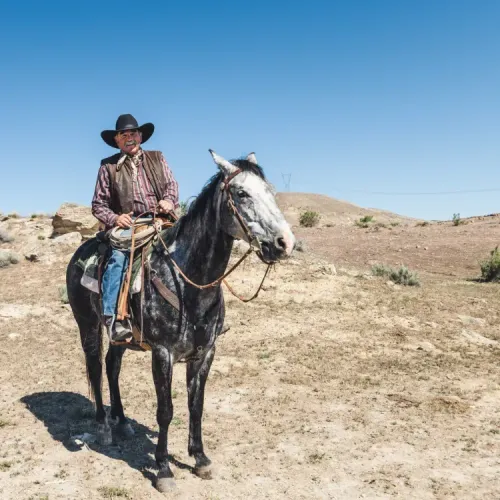
Table of Contents
Introduction
The United Kingdom is a country of animal lovers where horses carry light loads in comparison to many regions of the world. This is generally a good thing but it has become fashionable to quote the amount of weight a horse can carry as 10% of the horse’s fit body weight.
Now nobody wants to overburden their horses and equine welfare must always be the top concern for all riders and keepers of horses, however. adhering to this rule would prevent ridden activities. This rule suggests that a horse should carry no more than 10% of its body weight, including the rider and tack.
However, upon closer examination, it becomes evident that this rule is, in fact, a myth that does not accurately reflect the complexity of determining a safe weight limit for horses.
The 10% rule is not based on the weight of a typical horse!
A very typical weight for a modern show jumping warmblood of approximately 16.2hh is about 1350 pounds and the typical weight of an eventing horse is a little under 1150 pounds. These are known and accurate weights supplied by airlines carrying horses on long hauls to Olympic equestrian events.
Now, 10% of a 1150-pound eventing horse is only 115 pounds of weight. It is highly unlikely and almost impossible that any rider and saddle could make close to this weight.
Any percentage rule to calculate horse strength is oversimplification of horse physiology
Horses, like humans, vary greatly in their physical condition and fitness levels. The 10% rule fails to consider the horse's individual build, muscle mass, bone structure, and overall health.
For example, It's unreasonable to assume that a 1,000-pound endurance horse in peak condition can carry only 100 pounds, In fact, elite endurance horses have to carry no less than 165 pounds for sustained periods and frequently weigh about 900 pounds.
We must not ignore rider skill and balance when determining how much weight their horse can carry
The rider's skill level and ability to maintain balance significantly affect a horse's comfort and safety. An experienced, balanced rider can distribute their weight effectively, reducing the strain on the horse. Conversely, an inexperienced rider may put more pressure on the horse.
A horse's saddle affects the weight it can carry
The type of saddle being used will affect how much weight it can carry. A western saddle distributes the rider's weight over a large area and will be more comfortable for long hours in the saddle than a saddle that concentrates the rider's weight within a small area.
Endurance saddles distribute the rider's weight over a fairly large area and are lightweight in comparison to western saddles. English saddles are lightweight but do not distribute the rider's weight over a large area.
In general, horses ridden in western rig carry greater weights than horses ridden in English tack and cope with this because the type of saddle distributes the weight over a large area.

Article Suggestion
Heavy Riders need Happy Slim HorsesThe type of work a horse does affects the weight it can carry
Horse riding is not static; it involves dynamic movements such as walking, trotting, cantering and galloping. A horse can carry a heavier load at a walk than during more strenuous gaits. Fast and strenuous activities will necessitate lighter loads.
The horse's height and build affect its strength
As horse height increases, relative strength decreases. So small ponies are very strong for their size. Big draft horses have less strength in relation to their bulk. Other things considered the well-built horse is stronger than the horse with a lighter frame.
How to make informed decisions on the rider weight for our horses
Well, this is always up to the horse owner and has to be a consideration based on the following:
- The rider's skill and ability to stay in balance with the horse.
- The speed and intensity of the horse's job.
- The weight and type of saddle being used.
- The horse's height and build.
Informed and sensible weight limits must be set so that the horse's well-being is not compromised, but this never needs to be as low as 10% of the horse's body weight.
The 20% weight rule is sometimes considered to be a fair maximum weight for horses to carry and for many smaller horses, this is a sensible rule for strenuous activities. However, there are pitfalls and complications that must be considered when using the 20% rule.
So when is the 20% rider weight rule sensible?
Well, the 20% weight rule (ride and saddle) is a good starting point for considering how much weight a horse can safely carry. However, there are other variables than horse weight and just like humans, horse strength is not solely determined by body weight.
For more information on the 20% rule and the horses this works well for read this article.

Article Suggestion
Debunking the 20% Rider Weight Rule for Horse RidingThe take-home Message
Using horse weight as an indication of equine strength is not always correct. Certainly, all healthy slim horses can very easily carry 10% of their body weight and many will be able to comfortably carry 20% of their weight.
However, horse strength in relation to their size is also affected by conformation and this significantly impacts their strength. So two horses can be the same slim weight while one is far stronger.
FAQs
Can my horse carry 25% of its body weight?
Will my horse be able to carry 15% of its body weight?
Will my fat horse struggle to carry 20% of its body weight?
Will a healthy Arabian carry 20% of its body weight?
Can my small pony carry more than 20% of its body weight?

